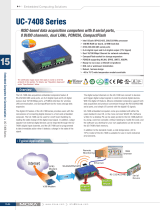
– 4 – – 5 – – 6 –
www.moxa.com/support
he Americas:
+1-714-528-6777 (toll-free: 1-888-669-2872)
Europe:
+49-89-3 70 03 99-0
Asia-Pacific:
+886-2-8919-1230
China:
+86-21-5258-9955 (toll-free: 800-820-5036)
2010
Moxa Inc., All
ights Reserved
Pin RS-232 RS-422/RS-485-4W RS-485
1 DSR – –
2 RTS TXD+ –
3 GND GND GND
4 TXD TXD- –
5 RXD RXD+ Data+
6 DCD RXD- Data-
7 CTS – –
8 DTR – –
CAN Ports (UC-8418 only)
The UC-8418 has 2 CAN
ports for connecting
CAN devices. The CAN
ports (CAN1 and CAN2)
use DB9 male
connectors. The pin
assignments are shown
in the following table:
Pin CAN
1 –
2 CAN-L
3 –
4 –
5 –
6 –
7 CAN-H
8 –
DI, DO
The UC-8410, UC-8416, and UC-8430 have 4 digital output
channels and 4 digital input channels, and the UC-8418 has 12
digital input channels and 12 digital output channels. Refer to
Hardware User's Manual for detailed pinouts and wiring.
CompactFlash
The UC-8410/8416/8418/8430 has one CompactFlash slot that
supports CompactFlash type I/II card expansion. Currently, Moxa
provides a CompactFlash card for storage expansion. Be sure to
power off the computer before inserting or removing the
CompactFlash card. The CompactFlash is mounted at /mnt/sda.
Console Port
The serial console port is a 4-pin pin-header RS-232 port that is
located below the CF card socket. Use a screwdriver to remove the
two screws holding the cover to the embedded computer’s housing.
The port is used for the serial console terminal, which is useful for
viewing boot-up messages. Use the CBL-4PINDB9F-100 cable
included with the UC8410/8416/8418-LX to connect a PC to the
UC-8410/8416/8418/8430’s serial console port.
Reset Button
Press and hold the “Reset” button continuously for at least 5
seconds to load the factory default configuration. After the factory
default configuration has been loaded, the system will reboot
automatically. The Ready LED will blink on and off for the first 5
seconds, and then maintain a steady glow once the system has
rebooted.
USB
The UC-8410/8416/8418/8430 computers support 2 or 6 USB 2.0
hosts for external storage expansion.
6. Powering on the UC-8400 Computer
To power on the UC-8410/8416/8418/8430, connect the “terminal
block to power jack converter” to the UC-8410/8416/8418/8430’s
DC terminal block (located on the left rear panel), and then
connect the power adaptor. Note that the Shielded Ground wire
should be connected to the right most pin of the terminal block. It
takes approximately 30 seconds for the system to boot up. Once
the system is ready, the Ready LED will light up.
7. Connecting the UC-8400 Computer to a PC
There are two ways to connect the UC-8410/8416/8418/8430 to a
PC: through the serial console port or by Telnet over the network.
The COM settings for the serial console port are:
Baudrate=115200 bps, Parity=None, Data bits=8, Stop bits
=1, Flow Control=None.
ATTENTION
Remember to choose the “VT100” terminal type. Use the
CBL-4PINDB9F-100 cable included with the product to
connect a PC to the UC-8410/8416/8418/8430’s serial
console port.
To use Telnet you will need to know the UC-8410/8416/8418/
8430’s IP address and netmask. The default LAN settings are
shown below. For initial configuration, you may find it convenient
to use a cross-over Ethernet cable to connect directly from the PC
to the UC-8410/8416/8418/8430.
Default IP Address Netmask
LAN 1 192.168.3.127 255.255.255.0
LAN 2 192.168.4.127 255.255.255.0
LAN 3 192.168.5.127 255.255.255.0
Note that the LAN1 of the UC-8410/8416/8418/8430-CE and
UC-8430-LX uses DHCP for both IP address and netmask. Once the
UC-8410/8416/8418/8430 is powered on, the Ready LED will light
up, and a login page will open. Use the following default Login
name and Password to proceed.
Linux:
Login: root
Password: root
Windows CE:
Login: admin
Password: admin
For the UC-8430, you may connect the display with the display
cable. After powering on the UC-8430, you will be able to access
the computer for further configuration.
8. Configuring the Ethernet Interface
Linux Models
If you use the console cable for first-time configuration of the
network settings, use the following commands to edit the
interfaces file:
#ifdown –a
//Disable LAN1/LAN2/LAN3 interface first, before you
reconfigure the LAN settings. LAN 1 = eth0, LAN 2= eth1,
LAN 3= eth2
#vi /etc/network/interfaces
//check the LAN interface first//
After the boot setting of the LAN interface has been modified, use
the following command to activate the LAN settings immediately:
#sync; ifup –a
Windows CE Models
Use the netconfig utility to complete the task.
Before using this utility, type netconfig -h to examine the usage
of thecommand.
\> netconfig –h
netconfig usage: netconfig -n <AdapterName | Alias>
[-EnableDHCP] [-i <IP address>] [-m <netmask>] [-g
<gateway>] [-d <DNS server>] [-w <WINS Server>] [-noask]
e.g.: netconfig -n IXP425ETHNPE1 -i 192.168.10.101 -g
192.168.10.254
: netconfig -n CS89501 -i 192.168.12.101 -m 255.255.0.0
: netconfig -n PCI\RTL81391 -EnableDHCP
For example, if your development workstation has a LAN port at
192.168.1.x and the Domain Name Server (DNS) is at 192.168.2.6,
then execute the following command.
\> netconfig –n LAN1 –i 192.168.1.5 –m 255.255.255.0 –g
192.168.1.254 –d 192.168.2.6
Type netconfig to view the new settings.
\> netconfig
Ethernet Adapter [IXP4XXETHNPE1]:
IP Address: 192.168.1.5
SubNet Mask: 255.255.255.0
Gateway: 192.168.1.254
DNS: 192.168.2.6
Ethernet Adapter [IXP4XXETHNPE2]:
IP Address: 192.168.4.127
SubNet Mask: 255.255.255.0
Gateway:
DNS:
NOTE: Refer to the UC-8410/8416/8418/8430 User’s
Manual for additional configuration information.



